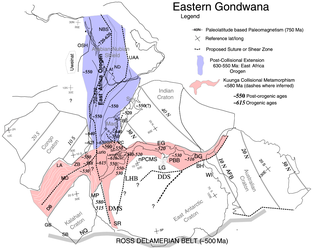East Antarctic Shield

The East Antarctic Shield or Craton is a
Background

Over the past 1 billion years,
- the stabilization of various Archean to Paleoproterozoic cratons before 1600 Ma
- the development of a high-grade late Mesoproterozoic to early Neoproterozoic (1300-900 Ma) mobile belt that roughly follows the modern coast of East Antarctica, and
- low- to high-grade late Neoproterozoic to Ordovician (550-450 Ma) tectonism in the Ross orogen, situated at the present-day Transantarctic Mountains, coupled with a static thermal overprint in much of the craton interior.[3]
Interaction with supercontinents
Rodinia: 1100–750 Ma
Gondwana: 550–320 Ma

Then came
The Ross Orogen comprises a deformed sequence of Neoproterozoic to Cambrian sediments.[9] These sediments were deposited at a passive margin that likely developed during the rifting of North America from the East Antarctic Shield, and were subsequently deformed and metamorphosed at a low- to medium-grade and intruded by syn- and post-tectonic granitoids.[3] Plutonism and metamorphism commenced at about 550 Ma with peak metamorphism at 540-535 Ma.[10] At this time, two more high-grade Cambrian mobile belts formed in East Antarctica, the Lutzow Holm Belt and the Prydz Belt. Tectonism was relatively synchronous between the two from 550 to 515 Ma and both belts overprinted late Mesoproterozoic to early Neoproterozoic, Grenville-age magmatic and metamorphosed rocks. The Lutzow Holm Belt separates the Grenville-age Maud and Rayner Provinces and is the southernmost segment of the East African Orogeny, which extended from East Africa to the Shackleton Range.[3] Evidence for ocean closure is well-documented in the East African Orogen and this is supported by the occurrence of ophiolite material in the Shackleton Range.[11] Further evidence for ocean closure along the Lutzow Holm Belt is provided by the different ages of Grenville-age tectonism in the Maud and Rayner Provinces of either side of the inferred suture. The climax of activity in both the Lutzow Holm and Prydz Belts was at 530 Ma, but the possibility of two-near-simultaneous collisions cannot be discounted and would mean that East Antarctica comprise three major crustal fragments that did not combine until the Cambrian.[12]
Pangea: 320–160 Ma

From 320 Ma onward, Gondwana,
Post Pangea: 160 Ma–Present
In the Late Jurassic and Early Cretaceous, the East Antarctic Shield began to move southward at a faster rate than Africa and South America, resulting in seafloor spreading between the two sub-blocks of Gondwana in the Weddell Sea, Riiser-Larsen Sea, Mozambique and Somali basins.[2] A long phase of extension and rifting took place in the southern Weddell Sea before the onset of seafloor spreading, dated around 147 Ma.[15] During the mid-Cretaceous, seafloor spreading propagated eastward from the Riiser-Larsen Sea to the Enderby basin between East Antarctica and India.[16] At 50 Ma, the inception of rapid northward drift of the Australian plate caused rapid accretion of oceanic crust on the East Antarctic Shield.[17] Relative extension between West Australia and East Antarctica commenced in the Late Cretaceous to Early Tertiary, but oceanic crust between these two plates was formed only between 45 and 30 Ma in the Adare Trough of the Ross Sea.[18]
See also
- Geology of Antarctica – Geologic composition of Antarctica
References
- ^ .
- ^ ISBN 978-0-309-11854-5.
- ^ .
- .
- S2CID 128667053.
- S2CID 129929345.
- ^ a b Kamanev, E. N. (1993). "Structure and evolution of the Antarctic shield in Precambrian". Gondwana Eight: Assembly, Evolution and Dispersal: 141–151.
- S2CID 131080096.
- ISBN 9780521019996.
- .
- S2CID 4999945.
- .
- S2CID 128812370.
- .
- .
- .
- S2CID 129191964.
- S2CID 4399729.












